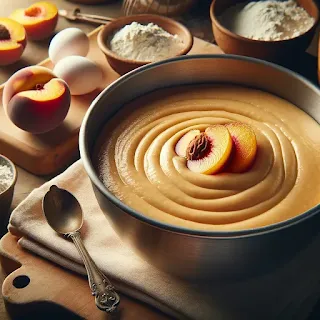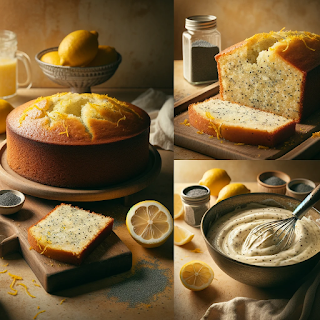This Blueberry Bundt Cake is a delightful and elegant dessert perfect for any occasion. It features a moist, tender crumb studded with juicy blueberries and a hint of lemon zest. Topped with a sweet lemon glaze, this cake is sure to impress your friends and family.
Origin Story: Blueberry Bundt Cake
Blueberry Bundt Cake is a delightful dessert that combines the sweetness of blueberries with the rich, moist texture of a bundt cake. This cake is perfect for special occasions, family gatherings, or simply as a treat to enjoy with a cup of coffee. The unique shape of the bundt cake, along with the vibrant burst of blueberries, makes this dessert both visually appealing and delicious.
Historical Roots
The Bundt cake, with its distinctive ring shape, has its origins in Europe, particularly Germany and Austria, where cakes baked in similar ring-shaped pans were known as "Gugelhupf." These cakes were often yeast-based and filled with nuts, fruit, and sometimes liquor.
The Bundt pan as we know it today was popularized in the United States in the 1950s and 1960s. The pan's design was patented by H. David Dalquist, the founder of Nordic Ware, who created it at the request of the Minneapolis chapter of the Hadassah Society. The pan gained immense popularity after a "Tunnel of Fudge" cake recipe won second place in the 1966 Pillsbury Bake-Off, resulting in a surge in demand for Bundt pans.
Blueberries, native to North America, have been enjoyed by indigenous peoples for centuries and became widely cultivated in the 20th century. The combination of blueberries and Bundt cake is a relatively modern invention, celebrating the freshness of blueberries within the classic structure of a Bundt cake.
Cultural Significance
Blueberry Bundt Cake holds a special place in American baking culture, particularly in regions where blueberries are abundant. It is often associated with summer, when blueberries are in season, and is a favorite for summer picnics, Fourth of July celebrations, and other warm-weather gatherings.
The Bundt cake's unique shape and ease of slicing make it ideal for serving at parties and events. The addition of blueberries adds a burst of color and flavor, making the cake not only delicious but also visually stunning.
Personal Connection
My journey with Blueberry Bundt Cake began with a desire to create a show-stopping dessert for a family reunion. I wanted something that combined the fresh, sweet flavor of blueberries with a cake that was easy to serve and enjoyed by all ages. The Bundt cake, with its beautiful shape and moist texture, seemed like the perfect choice.
Experimenting in the kitchen, I found that incorporating fresh blueberries into the batter and adding a lemon glaze elevated the cake's flavor profile. The result was a moist, tender cake with pockets of juicy blueberries and a zesty finish that delighted everyone at the reunion.
Recipe Evolution
Creating the perfect Blueberry Bundt Cake involves a few key steps. Using fresh, ripe blueberries ensures the best flavor and texture. Coating the blueberries in a bit of flour before folding them into the batter helps prevent them from sinking to the bottom of the cake.
The cake batter should be rich and moist, achieved by using a combination of butter, sugar, eggs, and buttermilk or yogurt. Adding lemon zest to the batter enhances the flavor, providing a subtle contrast to the sweetness of the blueberries.
Baking the cake in a well-greased and floured Bundt pan ensures it releases easily after baking. A lemon glaze, drizzled over the cooled cake, adds a touch of sweetness and a beautiful finish.
Sharing the Tradition
Today, Blueberry Bundt Cake is a favorite in my household, especially during blueberry season. It is the cake I bake when I want to impress guests with a beautiful and delicious dessert. Each slice is a reminder of the joy of baking and the simple pleasures of fresh, seasonal ingredients.
Ingredients
✅For the Cake:
- 2 1/2 cups all-purpose flour
- 2 teaspoons baking powder
- 1/2 teaspoon baking soda
- 1/2 teaspoon salt
- 1 cup unsalted butter, softened
- 1 1/2 cups granulated sugar
- 3 large eggs
- 1 teaspoon vanilla extract
- Zest of 1 lemon
- 1 cup buttermilk
- 2 cups fresh blueberries (tossed with 1 tablespoon flour)
✅For the Lemon Glaze:
- 1 cup powdered sugar
- 2-3 tablespoons lemon juice
Recipe Duration
- Preparation Time: 20 minutes
- Cooking Time: 55-60 minutes
- Yield: 12 servings
Instructions
Preheat and Prepare Pan: Preheat your oven to 350°F (175°C). Grease and flour a Bundt pan.
Mix Dry Ingredients: In a medium bowl, whisk together the flour, baking powder, baking soda, and salt.
Cream Butter and Sugar: In a large mixing bowl, beat the butter and granulated sugar until light and fluffy. Add the eggs one at a time, beating well after each addition. Mix in the vanilla extract and lemon zest.
Combine Wet and Dry Ingredients: Alternately add the flour mixture and buttermilk to the butter mixture, beginning and ending with the flour mixture. Mix until just combined. Gently fold in the blueberries.
Fill Bundt Pan: Pour the batter into the prepared Bundt pan, spreading it evenly.
Bake: Bake in the preheated oven for 55-60 minutes, or until a toothpick inserted into the center comes out clean. Allow the cake to cool in the pan for 10 minutes, then transfer to a wire rack to cool completely.
Make the Lemon Glaze: In a small bowl, whisk together the powdered sugar and lemon juice until smooth. Adjust the consistency by adding more lemon juice if necessary.
Glaze the Cake: Once the cake is completely cool, drizzle the lemon glaze over the top, allowing it to drip down the sides.
Pro Tips
- Toss Blueberries in Flour: Prevent blueberries from sinking by tossing them in a tablespoon of flour.
- Room Temperature Ingredients: Use room temperature ingredients for a smoother batter.
- Avoid Overmixing: Mix the batter until just combined to avoid a dense cake.
- Test for Doneness: Check for doneness with a toothpick; it should come out clean.
- Cool Completely Before Glazing: Ensure the cake is completely cool before adding the glaze to prevent it from melting.
Secret Tips
- Extra Moisture: Add a tablespoon of sour cream for extra moisture.
- Flavor Boost: Add a teaspoon of almond extract for an extra layer of flavor.
- Berry Variation: Use a mix of berries like raspberries and blackberries for a different twist.
Serving Options
- With Whipped Cream: Serve with a dollop of whipped cream.
- With Ice Cream: Pair with a scoop of vanilla ice cream.
- With Fresh Berries: Garnish with fresh blueberries and mint leaves.
- With Lemon Curd: Add a spoonful of lemon curd on the side.
- With Tea or Coffee: Enjoy with a hot cup of tea or coffee.
Health Benefits
- Blueberries: Rich in antioxidants and vitamins.
- Lemon: Provides vitamin C and a refreshing flavor.
- Buttermilk: Adds a tangy flavor and moisture.
Variations & Customization Options
- Gluten-Free: Use gluten-free flour.
- Vegan: Substitute eggs with flax eggs and use dairy-free milk.
- Nutty Twist: Add 1/2 cup of chopped nuts to the batter.
- Spiced Up: Add a teaspoon of cinnamon or nutmeg for a warm spice flavor.
- Chocolate Lovers: Fold in 1/2 cup of chocolate chips for a sweet treat.
This Blueberry Bundt Cake is a delicious and beautiful dessert that's perfect for any occasion. With its moist crumb, juicy blueberries, and tangy lemon glaze, it's sure to be a hit with everyone.
Happy baking!
Sam










